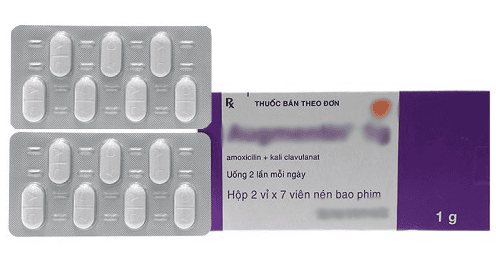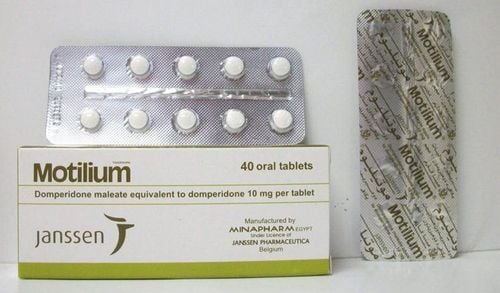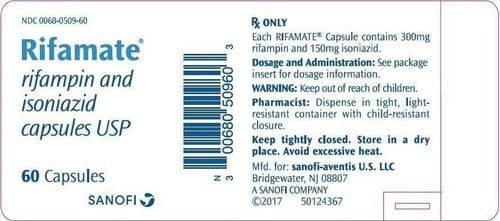This is an automatically translated article.
Amoxicillin and clavulanic acid (clavulanic acid + Amoxicillin) is a combination medicine used to treat bacterial infections.
1. What are the effects of Amoxicillin and Clavulanic Acid?
Amoxicillin and clavulanic acid drugs include 2 ingredients: clavulanic acid + Amoxicillin. In which, Amoxicillin represents the broad-spectrum penicillins, clavulanic acid is a beta-lactamase inhibitor. This medicine is made into many forms: tablets, powder for suspension for oral administration, injection,...
Amoxicillin and clavulanic acid are used to treat bacterial infections: Respiratory tract infections respiratory infections, intra-abdominal infections, genitourinary tract infections, animal bites, connective tissue infections, severe alveolar infections, prophylaxis of surgical infections,...
2. How to take Amoxicillin and Clavulanic Acid
You should take the medicine after a full meal or after a light meal (as directed by your doctor), usually every 12 hours. Note when taking clavulanic acid + Amoxicillin:
Do not use the drug with high-fat dishes because it may reduce the absorption of the drug; Do not crush or chew the extended-release tablet as it can spread medicines at the same time, increasing the risk of side effects; Antibiotics are most effective when the concentration of the drug in the patient's body is kept at a stable level. Therefore, patients should take the medicine at regular intervals, taking it at certain times of the day; Keep taking the medicine until your doctor tells you to stop (even if the symptoms have disappeared). Stopping the medication too soon can cause bacteria to continue to grow and lead to a re-infection. Patients should also tell their doctor if their condition does not improve or worsens.

Thuốc Amoxicillin và Acid clavulanic cần được dùng đúng theo chỉ định
3. Dosage of Amoxicillin and Clavulanic Acid
3.1 Adult Dose Infections caused by sensitive beta-lactamase producing bacteria: Adults and children 12 years of age and older take 250mg every 8 hours; In severe infections, 500 mg orally every 8 hours. If parenteral drug is used, then slow intravenous injection of 1g every 8 hours; In severe infections, the dose should be increased by 1g every 6 hours; Severe alveolar infections: 250mg every 8 hours; Prophylaxis of infection during surgery: Adults: 1g intravenously when pre-anesthesia, 2-3 doses of 1g, each dose 8 hours apart if there is an increased risk of infection. 3.2 Dosage for children Amoxicillin and clavulanic acid dosage for children depends on age as follows:
Infections caused by sensitive beta-lactamase producing bacteria:
Children 1 - 6 years old: 125mg every 8 hours; Children 6 - 12 years: 250mg every 8 hours; Neonates and premature infants: 25mg/kg every 12 hours; Children under 3 months: 25mg/kg every 8 hours; Children 3 months to 12 years: 25mg/kg every 8 hours, increased to 25mg/kg every 6 hours if infection is more severe. Dosage of Amoxicillin + Clavulanic Acid above is for reference only. The doctor will appoint the patient to use the appropriate dose depending on the age, nature of the disease, ...
4. Side effects when taking Amoxicillin and Clavulanic Acid
Patients should stop using the drug, notify the doctor immediately if experiencing serious side effects such as:
Watery or bloody diarrhea; Pale skin, jaundice, yellow eyes, fever, dark urine, weakness; Tingling in the skin, numbness, pain, severe muscle weakness; Bruising, unusual bleeding in the nose, mouth, rectum, vagina, or purple/red spots under the skin; Severe skin reactions, swelling of the face, fever, sore throat, swollen tongue, burning eyes, skin pain, widespread red or purple skin rash causing blistering and peeling,... Some side effects are less severe. Important when using the drug include:
Mild diarrhea, stomach pain, flatulence; Nausea, vomiting, headache; Rash, itchy skin; White patches in the throat or mouth; Vaginal yeast infections cause itching or discharge. Patients should notify their doctor if they experience unusual side effects while taking the drug.

Amoxicillin và Acid clavulanic có thể gây ra một số tác dụng phụ cho người dùng
5. Use caution when taking Amoxicillin and Clavulanic Acid
Before taking Amoxicillin and clavulanic acid, patients should note:
Tell your doctor if you are allergic to clavulanic acid, Amoxicillin, penicillin, cephalosporin or any other drugs; Tell your doctor about any medicines you are taking, especially allopurinol and probenecid, as your doctor may need to change your dose or monitor your health carefully; Tell your doctor if you have ever had liver disease, kidney failure, allergies, asthma, hives, allergic rhinitis, mononucleosis,...; Amoxicillin and clavulanic acid can reduce the effectiveness of oral contraceptives, so it is necessary to use another method of contraception while taking this medicine; Tell your doctor if you are pregnant, plan to become pregnant or are breast-feeding; Talk to your doctor before taking Amoxicillin + Clavulanic Acid during pregnancy or breast-feeding.
6. Amoxicillin and Clavulanic Acid Drug Interactions
Drugs Amoxicillin + Clavulanic Acid can interact with drugs: Allopurinol, Probenecid, antibiotics. If you are taking any of the above medicines, you should not take Amoxicillin + Clavulanic Acid or need to adjust your dose, perform special tests during treatment. Clavulanic acid + Amoxicillin may decrease the effectiveness of oral contraceptives. Therefore, while taking clavulanic acid and amoxicillin, the patient should use a non-hormonal method of contraception (condom, spermicide, diaphragm, ...) to prevent pregnancy. Amoxicillin and clavulanic acid are used to treat bacterial infections exactly as prescribed by your doctor. Patients should pay attention not to arbitrarily use the drug, stop the drug, prolong or shorten the time of drug use, ... to ensure the best treatment effect.
Please dial HOTLINE for more information or register for an appointment HERE. Download MyVinmec app to make appointments faster and to manage your bookings easily.













